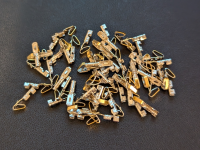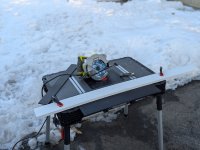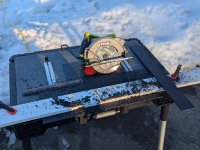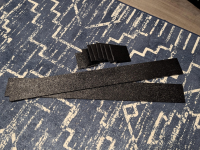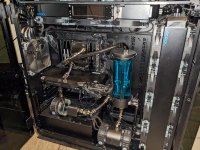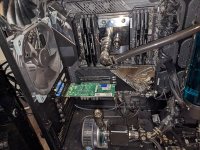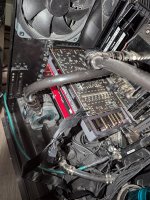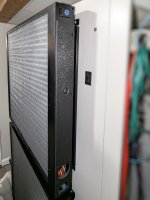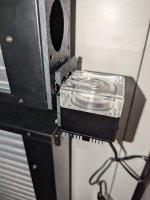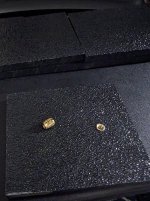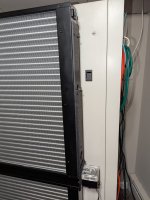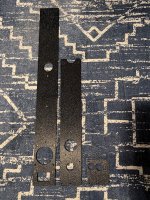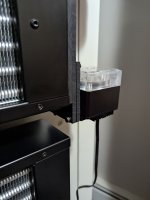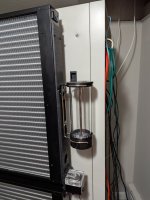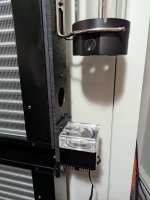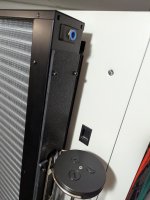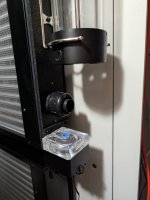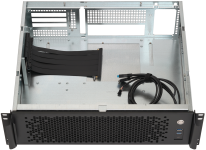Another weekend, another limited amount of progress.
I spent some time trying to duplicate my brackets for the second radiator. No pics here. There is nothing new to show off, and I have a little bit of trimming left to do before it will work just right, and I ran out of daylight before i got that done...
I'll say this. I'm an engineer. I am pretty good at being an engineer. But there is a difference between designing a place for a hole on a drawing, and actually making that hole.
I've always had a lot of respect for good fabricators/machinists. I am not one of those. This project has only reinforced my respect for those who are good at it.
So, I am not quite yet at the level of "manufacturing maturity" to be able to claim that I can make "replaceable parts". Each of these two brackets required significant fine tuning to get them to work, and replacing one of the layers with one from the other bracket would result in them just not fitting at all.

I also spent some time working on the C-channels I had originally bought to reinforce the side panel (which ultimately wound up being unnecessary).
I am re-using them as mounting bars for the box that will contain the fan controllers, power supply (and possibly some pumps).
I wound up cutting them down to 19" and then marked the cage nut holes on them:
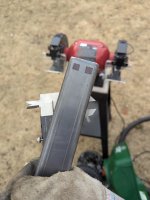
Then I went to drill the holes using my old ****ty drill press.
Last winter I had a mouse move in to my shed where I have my main workbench. I eventually wound up killing it with bait. I knew it built a nest in there somewhere, but I just couldn't find it. Well, I found it today:
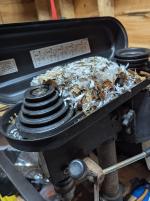
The little ****er was living inside of the top of my drill press. Got to hand it to him (or her, no idea) that was a pretty protected space. At least until someone went to turn on the drill press.
So, anyway, brief break to stop, clean out the top of the drill press and inspect for any chew marks or other damage, and then I drilled the holes.
I measured the screws that go into the cage nuts on the rack. They all seem to be 1/4". In order to give myself a little tolerance to play with and make everything fit, I decided to go up a size to 3/8".
This wound up looking pretty good:
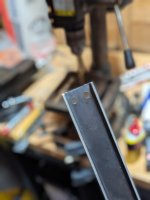
And of course, I had to do a test fit on the back of the rack, to make sure they will work:
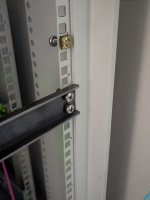
More to come...
I also did some thinking. Phase 1 of this project is to just move the workstation into the rack, but phase 2 involves building the new game machine.
My local MicroCenter has both 9800x3d's and 9950x3d's in stock now. They also have the motherboard I think I have settled on for that build. The MSI x870e MAG Tomahawk.
I have decided on this one because it both has a 4x PCIe slot off the chipset I can use for a 10gig NIC
and it is one of the few x870 or x870e motherboards that allow you to disable the 40Gbit USB ports and instead use those 4x Gen5 lanes off the CPU for a second CPU connected m.2 port.
I don't know if power stages and overclocking capability is any good (or if that stuff even matters anymore these days) but it seems like it is in the direction of what I want.
Thing is, this is not an official MicroCenter bundle. But the last time I bought a bundle from MicroCenter, they allowed me to customize it a bit and still gave me a bundle discount. I'm going to see if they let me do that with these.
Things I am not yet settled on:
9800x3d vs 9950x3d:
They seem to trade blows in games, which makes me think that the cheaper one (9800x3d) would be the smartest choice. That said, I could get a 9950x3d and just disable the non-X3d CCD, and essentially get a higher clocked (5.7ghz vs. 5.5Ghz ) 9800x3d.... And this would give me more flexibility. If I ever need to use it for anything that requires more cores, I can just enable them again...
In the past I wouldn't have cared this much about the CPU as I game at 4k, but the title I want to enjoy when this is all done is Stalker2, and it is crazy heavy on the CPU. If I don't wan' to use frame gen (which I don't) even the 9950x3d may not avoid minimum drops under 60fps. I generally see the 9800xrd getting better average frame rates, but the 9950x3d often gets better 0.1% minimums, which might be significant.
The 9950x3d is - of course - about $200 more expensive, but after the money I am dumping into this project, what's another $200? CPU's just aren't the significant part of a build (cost wise) like they once were...
Which RAM to buy:
I want to try for DDR5-6400 with a 1:1 MCLK:UCLK ratio, but this will involve a mild overclock of the uncore parts of the chip, which may or may not work based on silicon lottery.
I might just go with DDR5-6000 CL30, and try tho overclock it up there, instead of just trying to buy DDR5-6400 directly (in case the uncore overclock fails) Not sure.
Also not sure how much I need. I haven't thought much about RAM use in games for a long time. My workstation has had 64GB in it since 2014, so I am not even sure how much RAM a game-centric machine might need.
16GB is probably a bare minimum in 2025, but you can't even buy 8GB modules in DDR5. 32GB (2x16) is probably the standard recommendation right now. Not sure if I want to step it up to 48GB (2x24) especially if that makes me sacrifice latency.
Anyway, the reason I mention this is, I am not quite ready for phase 2 yet, and I am reticent about buying things too early and then not having a chance to test them before my return window (15 days at MicroCenter) closes. But on the flip side, it would really suck if by the time I got to phase 2, they were sold out...
So, I have some thinking to do about which RAM and which CPU I want, but I may just drive to MicroCenter and do a defensive Phase 2 buy in the next few days.
Appreciate anyones thoughts on the choices above.
